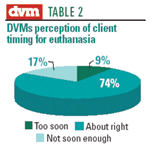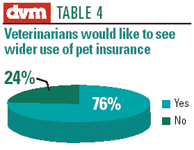Of life and death: Stop treatment points edge higher, DVM survey says
National Report - $1,451: It's the price most clients will stop treatment of a sick or injured animal, veterinarians report.
NATIONAL REPORT — $1,451: It's the price most clients will stop treatment of a sick or injured animal, veterinarians report.

Table 1. Average dollar amount most clients would stop treatment
During the last three years, the average has been on the incline, up 34 percent since 2003, according to an exclusive DVM Newsmagazine survey (Methodology). The escalating price could be reflective of our times, the growing importance of the human-animal bond and a profession that is steadily becoming more accepting of a third-party payment system to extend life.
While the result may be considered high in some areas, Dr. Victoria Young, a Caldwell, Idaho, practitioner in a six-doctor practice, sums it up this way: "You have some clients that price would be totally reasonable, but then you have the other side," which is any cost for veterinary care is just too high.
In an attempt to quantify an average stop-treatment point, DVM Newsmagazine sought to gain insight into the human-animal bond, the growing sophistication of veterinary medical delivery and veterinarian opinions about client attitudes regarding pet care.

Table 2. DVMs perception of client timing for euthanasia
Male and female veterinarians were united in their comparative estimates, too. Female DVMs averaged $1,432, and male veterinarians averaged $1,479. Major differences show up when cross-tabulated with a practice's gross revenues. Smaller grossing practices have smaller stop-treatment estimate price points. For a practice grossing $250,000-$499,999, the average was $1,069, while practices in the $1-million to $1.249-million category averaged $1,254. Practices grossing more than $1.25 million shot up to $1,718.
The decision to euthanize most frequently is left up to clients according to 75 percent of respondents; the other 25 percent of cases are initiated by the doctor's recommendation, the survey reports. Three-quarters of veterinarians report their clients' decisions to euthanize are "about right." About 17 percent of cases were considered "too soon", and the other 9 percent were "not soon enough."

Table 3. Who talks to clients about euthanasia?
Veterinarians were asked to estimate how heavily costs weighed on a client's decision to continue treatment of a sick or injured animal.
In 2006, veterinarians report that in about 38 percent of cases, cost limited treatment, another 32 percent report that cost influenced his or her decisions to treat, and 41 percent of respondents cite that cost was not a factor at all (multiple answers were allowed).

Table 4. Veterinarians would like to see wider use of pet insurance
While cost remains a barrier to extended care since veterinary services are primarily based on discretionary income, 76 percent of responding veterinarians say they would like to see wider use of pet health insurance. Eighty six percent of associate veterinarians like pet health insurance as a payment option compared to 72 percent of owners.

Table 5. Percent of practices that actively recommend pet health insurance to clients
Practice owners were also a little less likely to actively recommend it.
Veterinarians report they euthanize an average of 6.6 dogs and 5.4 cats each month. About 40 percent say they are approached several times a year to euthanize healthy animals. Another 40 percent are asked to put down a healthy animal yearly or less.
When asked to check reasons for requests to euthanize healthy animals, behavior-related problems were named by 90 percent of the respondents. Moving, change in family status (death or divorce), allergies and the costs associated with pet ownership were all cited far less frequently.